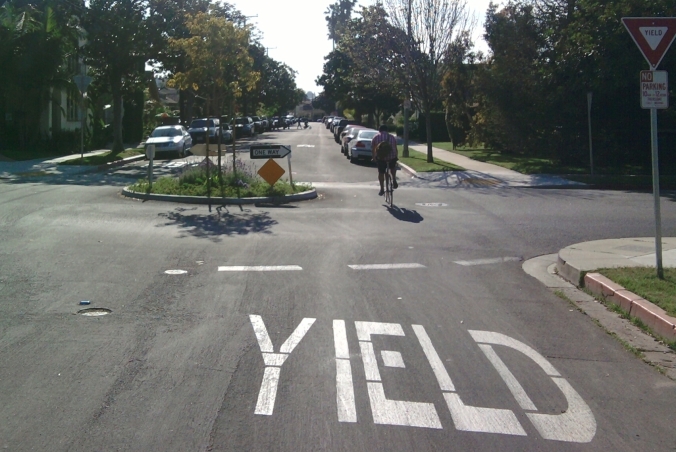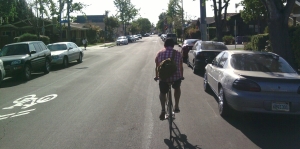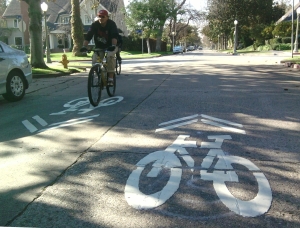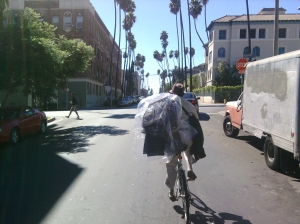“[L.A. City public works are implemented with] utter contempt for merchants and neighbors.”
– Rick Cole, City Manager, City of Ventura, speaking at the Complete Streets conference, Little Tokyo, Los Angeles, 26 February 2011
There’s Vista Street in Long Beach and there’s 4th Street in Los Angeles. Long Beach’s Vista Street is a more-or-less completed Bicycle Boulevard facility already serving to improve the quality of life in a city where cyclists are valued. 4th Street in Los Angeles is an incomplete “bicycle friendly street” in a city that values cars over quality of life and safety.
I think it’s informative to explore the differences between these two projects.
![4SBB-DraftConcept_AARLINE_CatalinaIslands_Perspective[1]](https://laecovillage.files.wordpress.com/2011/09/4sbb-draftconcept_aarline_catalinaislands_perspective1.jpg?w=676)
Bicycle activist generated vision for a Bicycle Boulevard diverter treatment at 4th and Catalina. Image by Aaron Kuehn, based on concept by Joe Linton
How Long Beach’s Vista Street Became So. Cal’s First Bicycle Boulevard:
If you haven’t ridden lately in Long Beach, stop reading, hop the Blue Line and check it out. They’re doing great stuff, and it’s been written about here, here and at L.A. Streetsblog.
When the city of Long Beach decided to create a Bicycle Boulevard, city staff reached out to bicyclists and worked with them to select Vista Street.
Vista Street is residential, two lanes. In the initial phase, sharrows were added. In the second phase, the city of Long Beach planned to add six traffic-calming roundabouts/traffic circles. Long Beach sent out their mobility coordinator, Charlie Gandy, to talk with the neighbors. When Gandy finished talking, the neighbors asked for more traffic calming – the number of circles increased from six to eight! The city added a new signal at the intersection of Vista Street and Redondo Avenue. The new signal only allows bikes to go straight across and diverts car traffic off of Vista.
The project is in. It looks great. It works well. Cyclists and pedestrians use the street, so do cars.
How L.A.’s 4th Street Didn’t Become a Bicycle Boulevard:
When the city of Los Angeles decided to create a Bicycle Boulevard, after years of cyclists pushing for “4SBB”, city staff were too timid to actually call it a Bicycle Boulevard and created a whole new poorly-understood term in their oft-delayed Bike Plan. It’s not a Bicycle Boulevard, no, it’s a “Bicycle Friendly Street.”
Fourth Street is residential, two lanes. In the initial phase, sharrows were added. In the second phase, the city of Los Angeles came up with some kind of plan… I think… I dunno… I am hard pressed to find it anywhere on-line. If it exists, it hasn’t been made public… hasn’t been shared with bicyclists.
Here LADOT announces the project on its website (May 2011):
4th Street… Bicycle Friendly Street … will include a large amount of community outreach. Staff is currently developing concept designs for various treatments, and the next step will be to obtain community support for specific projects before moving forward with final design of the first round of treatments.
Then the next thing I heard about the 4th Street project is that LADOT has presented it to Hancock Park homeowner groups… I think – it’s unclear… never announced to my email, and I’m involved and following this. I only know this meeting happened because the aftermath. Here’s an excerpt from a homeowner’s email, forwarded to me by a bike activist whom I trust. I don’t have this person’s permission to print this, so I am not going to name the author:
[…] Adding stoplights at 4th and Highland and 4th and Rossmore is a huge concern in the Hancock Park, Windsor Square and La Brea
Hancock neighborhoods. […] The stoplight at Rosewood and Highland which was installed to aid pedestrians has caused a huge “cut through” problem and Rosewood has become a speedway…not calmer due to that light. […] the plans currently proposed for 4th street have strong opposition.
WTF?!? How on earth did a bike boulevard project turn into the installation of two signals opposed by the neighborhood due to cut-through traffic? I actually really agree with this homeowner’s criticism… one of the most important things about designing a bike boulevard is to make sure it doesn’t result in more cut-through car traffic. How on earth did the LADOT present their still-not-publicly-available plans for these areas in such a way that the neighbors saw them as creating cut-through car traffic? Were the plans bad? Was the presentation unclear?
Last week the second shoe fell. Here’s an email I received from a (sorry again uncredited as I haven’t checked with the sender for permission to quote) bicycle advocate:
[I attended the] Greater Wilshire Neighborhood Council meeting last night [Wednesday September 14th]. Councilmember LaBonge made a surprise appearance and announced that he was not supporting the bicycle crossing lights at Highland or Rossmore. Furthermore, he stated that the project should be moved to Sixth between Wilton and Fairfax, possibly as a road diet. […] Tim Fremaux of DOT stated they would not be pursuing the crossing lights [at 4th/Highland and 4th/Rossmore]. The Hancock Park residents were well represented and submitted over 100 signatures opposing the lights. The GWNC then approved a motion to oppose the lights.
When LADOT talks with neighbors, they get two fewer bike-friendly features. A huge contrast from Long Beach where they get two additional bike-friendly features.
What Happened?
I wasn’t at these meetings, so I am going to speculate on a couple of causes… this is my guess.
1) LADOT has lost the trust of the public. LADOT has a culture of lying, not sharing information, and foisting unpopular projects announced as done deals. Generally a lot of us cyclists feel like we’ve borne the brunt of this, but most neighborhoods and businesses feel the same way as we do; see the Rick Cole quote at the top of this post. I can completely relate to the GWNC… when LADOT comes into my community with a plan, I am generally inclined to oppose it, solely based on their track record. If the LADOT wants to put a project on a street, it can be assumed that the project will increase cut-through traffic.
2) LADOT doesn’t have confidence in the benefits of bike projects. It may be a bit of a stretch, but, to explain this, I am going to invoke Dan Savage, a great advice columnist. Savage frequently advises folks with sexual kinks to communicate the kinks to their lovers. If feet (or leather or whatever) turn your sexual crank, he advises you to tell your partner, but don’t make it sound like you’re telling them like you have leukemia, make it sound like it’s a fun new Christmas present you’re giving them. So, when LADOT goes into a community and says “we’ve got a bike project on your street,” they can make it sound like “we’re giving your street leukemia” instead of “we’re giving your street a Christmas present.” LADOT needs to bring on folks like Long Beach’s Charlie Gandy – people who understand the value of bike projects, and who can communicate them with the general public. In some ways this could happen if LADOT chooses to treat L.A.’s bicycling communities (and, frankly, L.A.’s Neighborhood Councils, businesses, y mas y mas) as collaborators instead of as adversaries. That’s easier said than done. It’s going to take real culture change at John Fisher’s LADOT before the department embraces bicycling, walking, and a collaborative community-oriented quality-of-life approach to transportation infrastructure.
Where does it all go from here? I am not sure. It looks like LACBC’s 4th Street Bicycle Boulevard Campaign is reviving and considering our options (to get involved sign up for Google Group here.)
My hunch is that cyclists will need to focus on making the eastern portion of 4SBB happen first. 4th Street has a few apartment-lined miles in Koreatown and Ramart Village neighborhoods – which are much more population-dense and have higher levels of bicycling and walking than the more single-family residential neighborhoods west. I worry that LADOT will pull back the entire project after the drubbing they’ve received at GWNC… so we cyclists need to get out ahead of LADOT in organizing support for the project in Koreatown. Maybe we cyclists can begin to dialogue with GWNC folks, too, whose concerns we share…
We’ll see.




Interesting…I recently started a part-time job in the Miracle Mile district and 4th (and 6th west of La Brea) is my bike commute route. Although I can count on one hand the number of cars that pass my by on 4th (at least from Oxford to Sycamore), I’d also like them to address the uneven pavement through there.
City workers taking taxpayer dollars to serve the rich and flush cars through the intestines ofLos Angeles.
Christ, what a mess.
Pingback: Streetsblog Los Angeles » Today’s Headlines
The 4th Street Bicycle Boulevard is such an easy slam dunk. Maximizing tax dollar return from simple street features that improve safety and quality of life for everyone along the route, while developing desperately needed bicycle infrastructure. To alienate cyclists and neighbors from the project at this early stage is embarrassing. I agree that LADOT in it’s current form is obviously incapable of carrying out the bicycle plan. Does a separate agency need to be created, a task force if you will, populated with people who give a damn about our streets, and who are capable of reading the plans that they write?
@Alex – re: “City workers taking taxpayer dollars to serve the rich and flush cars through the intestines ofLos Angeles.” I am not sure that it’s about serving the rich… The rich aren’t asking for more traffic. LADOT is stuck in a mid-20th century mindset that as you state “flushes cars” whether the rich/poor/middle like it or not.
Received this comment via email and passing it on anonymously:
“JOE! Your analogy of the way LADOT presents bike projects to the public, like an oncologist explaining a complicated cancer illness to a patient, is spot on. Confusing, big words, complex, not really meant for you to understand anyway, and just obligatory instead of explanatory. Very funny and made me smile.
I wish they could hire you to do their outreach, and deliver all of those future Christmas presents!!”
We’ll have an update on 4th St. up on the LADOT Bike Blog soon. Thanks all.
I don’t get why they insisted on stop lights when the obvious answer is a crossing stripe and a manually activated light for pedestrians and bikes.
I ride on 4th all the time, joggers and peds and strollers outnumber cars by a big margin. They should emphasize that it’s the safety of those on foot that’s the main concern here.
Pingback: Important meetings on Main St road diet and Verdugo Ave bike lanes tonight, and bike safety in Signal Hill « BikingInLA
@Joe: “The city added a new signal at the intersection of Vista Street and Redondo Avenue. The new signal only allows bikes to go straight across and diverts car traffic off of Vista.”
There is a signal, and lane markings and signage indicating that cars mustturn right, but unfortunately there’s nothing preventing cars from going straight on Vista across Redondo Ave. Google Streetview captures this:
http://g.co/maps/yjztq
Click on the “up” arrow to continue east towards Redondo in Streetview and you’ll notice that the USPS van that approaches Redondo from the east continues straight on Vista! A diverter funneling cars into a right turn would be good.
Evan, no need to notice the USPS van….the google car also goes straight! You can follow the guy on the bike
Duh…of course, I forgot to mention that!
Joe, you’re really not giving the whole story here.
1) It would not promote cut-through traffic because the bike signals loop detectors would only be triggered by bikes, cars wouldn’t be able to use the signal. There would be roundabouts installed, as well as chicanes, the Bike Plan specifies 3 traffic calming measures. If anything this street would greatly reduce cut through traffic, it’s much less attractive when you can’t blow through a stop sign (a roundabout would prevent that from happening)
2) The homeowners were opposed due to a misinformation campaign where the cost of the project was doubled, residents were told that there would be huge increases in traffic on Highland and Rossmore, and that stop signs would be removed without having a roundabout in stead. In this vision, of course one would be opposed! But this vision is not the reality! I think you’re to hasty to throw the DOT under the bus, they’re working to help the bike community in the face of an unwilling Mayors office and a homeowners constituency who’re going door to door to prevent this from happening. How can the under resourced Bike Team compete with rich housewives who have nothing else better to do than go door to door and stand on their soapbox? Place the blame on the HPHOA not the DOT.
3) Also in original mock-ups found on the DOT bike blog, there was a median extension at Highland which would’ve physically blocked cut through traffic! But the homeowners were opposed to these measures because they wouldn’t be able to use the street themselves. First they neuter the project to something that conveniences them, then attack the project for allowing cut through traffic. There has to be a give a take at some point. It’s unbelievably selfish.
Pingback: Think Bike – LADOT to CalTrans Engineer: You’re Outta Here | Bikeside LA
Joe,
I am interested in your concept drawing for 4th and Catalina, which shows the bike lanes in the center of the street – would that be true for the full length of the bike boulevard? It is a wonderful statement about which form of transportation is supposed to take precedence, but I wonder how comfortable bicyclists would feel out in the middle of the road?
My father-in-law lives in Hancock Par/Windsor Square and never learned how to ride a bicycle. As a result, he has no appreciation for what a bicycle boulevard means to a bicyclist. He does have experience with bicyclists, and, in his view, more often than not, he is slamming on his brakes because yet another bicyclist has flown through a stop-signed intersection without stopping, or yielding to existing traffic. He does not see a need to accommodate bicyclists who do not follow traffic laws, and in his view, that would be most cyclists.
Promoting the 4th St. Bicycle Boulevard in Hancock Park/Windsor Square might require emphasizing the reduction in cut through traffic, and not so much the bicycle aspect. However, if there is a worthwhile design for 4th St., I would be happy to try and talk at least one resident in to approving the concept.
@Ian – not for the whole length (there’s only one jog intersection the whole way – at Catalina. It depends on the site, but places like Long Beach, San Luis Obispo, Berkeley, etc. etc. will put one actual traffic diverter only every 2-3 miles – just to get rid of overall cut-through traffic. You don’t need a lot of these. The idea is that if you can slow down some cars and divert some cars, you get a street that prioritizes bikes and peds.
From Portland studies, a lot of bicyclists – especially less confident ones, feel more comfortable using these quieter more residential street facilities.
Pingback: Streetsblog Los Angeles » The 4SBB, Homeowner’s Groups and How to Avoid a Bikelash
Pingback: Some Good Bicycle News – from Culver City and Mar Vista « L.A. Eco-Village Blog
Pingback: Analyzing and Mapping L.A.’s 5-Year Plan for Bikeway Implementation « L.A. Eco-Village Blog
Re-reading this after a fashion has me thinking about my own city. In LA, with some leadership from the Mayor, DOT got out in front of stinging criticism about the bike plan process (including genius mock site and DIY sharrows). Since then they’ve been much more active. But reality is reality. As a DOT managing engineer told me, “We work for the Council offices.”
At least uncertain progress against ever-changing political winds is some progress. Sure, DOT will back down if it has to.
Here in Beverly Hills, there is a prior restraint on innovation. That is, the transportation officials charged with protecting all road users utterly cave. Not to direct political pressure; but to presumed pressure. Not to a well-organized homeowners group (we do have those) but to the specter of threat from such groups.
I had a revealing conversation with the PW deputy over transportation. He attributed the city’s reluctance to cut into our wide lawn an inch for bike lanes on SM Blvd. is because of community resistance to expansion. But that’s no proposal has been floated. That resistance was many years back owing to adding another traffic lane in each direction.
Duh – who WOULDN’T be opposed to that? But an active transportation corridor?
Then I realized that the fear comes from presumed opposition. So, no action is taken. And I believe that in the department itself, that same fear pervades. It’s hostile to innovation and even imagination.
The other day I was headed to the post office on Western and decided to take my bike along 4th Street, even though it took me a block out of my way. I just moved here, so I wasn’t sure what to expect. I have to admit I was pretty disappointed. There wasn’t a lot of car traffic, but the ones that were there all piled up behind my bike and started zooming around me, which obviously made me nervous. My overall impression was that this was just a typical street with a few sharrows painted on. It’s still too wide and doesn’t have any traffic calming. I see no reason to use it on a bike unless it leads directly to your destination.
I guess I don’t see why 4th was chosen in the first place. In an urban setting, a lot of bicyclists are riding for practical reasons, not just recreation. When you’re taking your bike to the grocery store or office or whatever, you want your path to lead you directly there. You don’t want to ride several blocks out of your way, just to take a street that isn’t much safer than a normal one. I’d rather the city take some more of the cross streets leading to 3rd street and make them boulevards like they did on New Hampshire. Well marked bike lanes on both Vermont and 3rd would be nice, too. Why strand us on 4th street?
@Roland – Definitely the plan would be not to stop at just implementing a safer more bikeable 4th Street, but to do the planned bike lanes on Vermont and elsewhere. In looking at what to do first, it’s often useful to start with the “low hanging fruit” before doing the more challenging, more pushy projects.
Keep riding and let’s work together to make all of Los Angeles a great place to bicycle.
It ‘s good to know they don’t plan to stop with just 4th street. I see a relatively large number of cyclists riding on Vermont already.
How could I get involved in bicycle and pedestrian planning around here?
Pingback: $312 million updated Bike Plan passes with unanimous support from City Council | BikeSD
Pingback: Morning Links: KPCC calls LaBonge a bike advocate, CicLAvia rolls, Kerry breaks a leg and Hövding sort of works |
Pingback: Assume Bike – LADOT to CalTrans Engineer: You’re Outta Right here | Posts
Pingback: LADOT Hosts Traffic Safety Pop-Up Installations – Streetsblog Los Angeles
Pingback: One Angeleno’s Coronavirus Pandemic Diary: Day 23 – Safe Public Space In Los Angeles – Streetsblog Los Angeles
Pingback: Eyes on the COVID Slow Street: Sandwich Boards Not Quite Enough to Make 4th Street Walk/Bike Friendly – Streetsblog Los Angeles